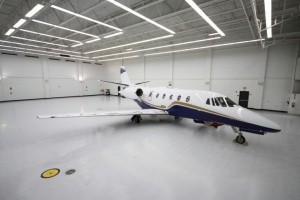Aircraft maintenance, storage and display hangars require durable, high-gloss, bright and light-reflective aircraft hangar floor coatings.
For hangar owners, a persistent concern has been that glossy floor coatings meant slip and safety hazards. A high-gloss, smooth, floor will certainly be easy to clean and will reflect a great deal of overhead light. But, walking on a wet, glossy floor can spell disaster. The term “ice skating rink” comes to mind here.
Available Options
-
- Bare Concrete: An uncoated concrete floor is porous and dull. Not only does it not reflect light, it is not very impact and abrasion resistant, and is very difficult to keep clean. Additionally, hazardous aviation fuels and related chemicals can seep into the substrate and penetrate down to the water table below so you need to consider aircraft hangar floor coatings.
-
- Sealed or Polished Concrete: A better option than bare concrete, polished concrete will allow some light-reflectivity and general durability and abrasion-resistance characteristics to your floor, but the gloss sheen on the floor is not very slip-resistant, creating a safety issue.
-
- Ceramic or Vinyl Composition Tile: Only presented here as an alternative option, these systems are not recommended simply due to the increased labor involved in installing and maintaining these systems.
-
- Polymer Floor Coating Systems: There’s no doubt a polymer floor coating system is the best option for an aircraft or maintenance hangar. The areas can be quite large and a liquid-applied floor is certainly the most overall time and cost-effective option. Additionally, polymer coatings offer superior durability, chemical-resistance and abrasion-resistance properties. But, like polished concrete, they are “slippery when wet”.
So, how can a polymer floor be modified to address not only the required performance characteristics of the aviation hangar industry, but also address traditional safety concerns of high-gloss “slippery” aircraft hangar floor coatings?
Some manufacturers have adopted the practice of broadcasting angular quartz aggregate, or “grit”, into the wet coating to increase slip-resistance properties. True, these aggregates enhance the safety characteristics of the floor, but because this “grit” is sharp and angular it greatly dulls the surface reflectivity and is very difficult to keep clean.
Having Your Cake….and Eating It Too
There are polymer floor coating surface texture additives available for hanger floor projects that can help you achieve the best of both worlds. Instead of being broadcast into a wet polymer coating as explained above, these additives are designed to be field-mixed, on the jobsite, into the polymer components prior to roller application of the polyurethane topcoat.
A product like Protective Industrial Polymers’ GlossGrip can help produce a durable, bright, high-gloss floor coating that is easy to clean with greatly enhanced slip-resistance.
GlossGrip is a micro-spherical safety and wear additive that is mixed into the polyurethane topcoat of a polymer flooring system. This creates a more slip resistant and better wearing surface profile texture, while retaining a high-gloss, easily cleanable finish.
Unlike traditional angular aggregate broadcast additives that rely solely on installation skill, the GlossGrip additive is incorporated into the polymer system matrix during mixing, providing a more even distribution of wear and safety enhancement. With GlossGrip you can achieve consistent, repeatable surface profile textures.
GlossGrip Benefits:
- 50% Greater Wear
- Excellent Gloss Retention
- Easy-to-Clean
- Longer Service Life
- Repeatable Textures
- Lower Maintenance Costs
Building aircraft hangar flooring or maintaining an existing one? Your floors are an integral part of the process, and we can help with our consultative approach. Sign-up for our FREE HangarSpec Floor Systems informational kit and we will ship it right out to you.
- A Faster Cure for Flooring Needs: Polyaspartics in Action - April 8, 2025
- The Case for Epoxy Mortar in Manufacturing - April 8, 2025
- Epoxy Mortar Flooring: Built for Heavy-Duty Performance - March 29, 2025




